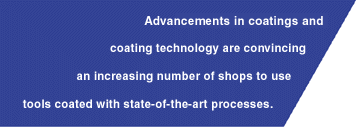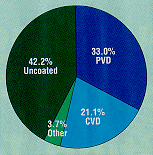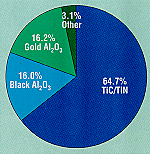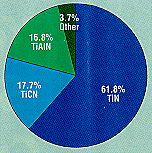Since the first coating and coating process were introduced, the
industry has recognized that applying a hard surface to a cutting tool will enhance the tool’s performance and extend its useful life. Further gains in performance and tool life have been achieved each time an advancement in equipment and technology has made it possible to develop new coatings. Today, there are several coating processes and numerous types of coatings being used on a wide range of tools.

Some shops continue to use a particular coating because they are content with the general increase in production it has given them. They are reluctant to change, despite the fact that a newer coating might provide even better results. Such reluctance puts these companies at a competitive disadvantage. To continue to offer customers the best work and service for the price, a shop must consider all available coatings and determine which coating is best suited for a given application.
A nationwide survey was conducted recently to determine how coatings are being used and to discover what industry trends will be driving the use of coatings into the year 2000. These findings can provide support for the coating decisions that shop owners and managers are making, or they might highlight the need for change.
Two Processes Predominate
According to the survey, more than 90% of all tool coatings are applied using either the physical vapor deposition (PVD) or the chemical vapor deposition (CVD) process. Each process offers the tool user advantages under specific conditions. By following a few simple guidelines, the user can determine which process is most likely to maximize production for a given application.
PVD is the most widely recognized coating process. Simply put, PVD is a line-of-sight process. This means that the hard coating material is transferred from a source to the tool, traveling in a straight line. PVD coatings usually are applied as a single layer of titanium nitride (TiN), titanium carbonitride (TiCN), or titanium aluminum nitride (TiAlN). PVD coatings have two distinct advantages over CVD coatings. First, the coatings’ 3µm to 5µm thickness works very well on sharp-edge tools, where a thicker coating might have trouble adhering and cause a dulling effect. Second, PVD is done at relatively low temperatures; therefore, it can be used on HSS and tool steels without adversely altering the steel’s underlying properties.
During the CVD process, the coating is virtually grown on the surface of the tool. Coatings applied with the process have three distinct advantages over PVD coatings. First, the CVD process will generally result in a better bond with the substrate, and better adhesion can result in increased performance. Second, the CVD process allows for much thicker coatings, which means more protection for the cutting edge and a potentially longer tool life. Third, tool coaters can apply a variety of multilayer coatings with the CVD process. By combining several different coating layers, the coater can take advantage of each layer’s unique strength. The end result is a coating that will make it possible for users to achieve a greater increase in production than they could achieve with any one layer by itself.
The first CVD coatings were single layers of titanium carbide (TiC) about 5µm thick. Today’s CVD coatings range in thickness from 3µm to more than 14µm. CVD coatings are typically applied in multiple layers, combining TiC, TiCN, TiN, and aluminum oxide (Al2O3) in a variety of ways to create the finished product. CVD is now being used successfully in turning, milling, threading, grooving, extrusion, and many other applications.
Historically, tool coaters and shops have chosen to use the PVD process to coat sharp edges on such tools as indexable inserts, form tools, drills, and endmills because the thin-film coating produced by PVD worked best for these applications. But advancements in the CVD coating process have made more choices available. With more precise automated control of the CVD process, coaters can apply a much thinner coating with consistency and repeatability. This has made it practical for several companies to offer a thin-film CVD coating for sharp-edge tools.
Thin-film CVD coatings have proven to be effective on a variety of carbide cutting tools, including standard inserts, top-notch inserts, form tools, threading-and-grooving tools, and many other styles. Researchers also have tested these coatings on carbide drills and endmills, but their preliminary findings show that thin-film CVD coatings do not boost performance in these applications. Therefore, PVD may still be the coating of choice for drilling and endmilling. PVD continues to be the first choice for coating tight-tolerance steel as well.
Aluminum Oxide’s Role
A growing number of shops are using tools PVD-coated with TiAlN. The coating provides excellent results in applications that generate high temperatures at the cutting edge. When enough heat is generated, the aluminum in the TiAlN reacts with the oxygen in the air to create a microthin layer of Al2O3 at the cutting surface. As this layer is created and worn away during the cutting process, it provides heat protection for the cutting tool and potentially longer life.
Many CVD coatings also benefit from a layer of Al2O3. Typically, it is included as one of the layers in multilayer coatings. PVD-applied Al2O3coatings are not available, because it is not possible to create oxides such as Al2O3 economically using PVD equipment.
An Al2O3 layer that is created during the coating process rather than during the cutting process performs better for several reasons. One reason is that the Al2O3 that is created during the CVD-coating process is much thicker than the microthin layer of Al2O3 that is generated while the tool is in the cut. Also, an Al2O3 layer that exists in the coating before the tool begins cutting can provide heat protection with the first cut and can benefit the tool even when temperatures do not rise sufficiently to create an Al2O3 layer on the fly.
It may be said that Al2O3 provides the protection in both TiAlN and Al2O3coatings. Users must decide which use of Al2O3 will provide the longer tool life for their applications. If the tools being used require a PVD coating, TiAlN might be the best choice for improved heat protection. If the tools can be coated using the CVD process, however, the user might achieve even higher performance by selecting a multilayer coating that includes a layer of Al2O3.
Common Misconceptions
Many in the metalcutting industry base their opinions about PVD and CVD coatings on what they may have heard or experienced in the past. But because of advancements made to the processes since, these beliefs may no longer be true. The following examination of some of the most commonly held misconceptions provides updated information.
CVD does not adhere to a sharp edge. One of the advantages of the CVD-coating process is the ability to create coatings that are much gs. However, thick-film coatings are more easily broken off of sharp edges than thin-film coatings are. This has led many to doubt the ability of any CVD coating to adhere to a sharp edge. Thin-film CVD coatings, however, adhere extremely well to sharp-edge tools, proving that it is the coating’s thickness, rather than the CVD process, that impairs the coating’s ability to adhere to a sharp edge.
The high heat associated with CVD produces eta phase on sharp-edge tools. The coating equipment and the composition of the material being coated will have a greater influence on the formation of an eta phase than the coating process itself. (See “Some Good News About Eta Phase” in the February 1998 issue of CUTTING TOOL ENGINEERING, p. 24.) In a poorly controlled environment, a disastrous layer of eta phase can be formed. However, in a well controlled environment, eta phase can be controlled without regard to the temperature of the furnace or the edge preparation of the tool.
PVD is superior to CVD. PVD is an excellent process, and it can provide superior results in certain applications. However, PVD is not better than CVD. Nor is the opposite true. Each process has its own strengths for certain applications. The user must avoid preconceived notions about the processes to determine which process will provide the best results for the application at hand.
Survey Finds CVD Growing
The recent survey on coatings tallied responses from small to large companies coating a variety of tool materials. Certain patterns emerged when the results were grouped by the size of the company responding or the type of material being coated. To analyze these patterns, the responses were separated into four groups: large companies spending more than $50,000 per month on coatings; small companies spending less than $50,000 per month on coatings; companies coating (more than 60% of the tools they coat are carbide); and companies coating primarily steel tools (more than 60% of the tools they coat are steel).
A sharp difference could be seen in the responses of large and small companies when they were asked what percentage of the tools they use or sell are coated. Respondents from smaller companies said 45% of their firms’ tools are uncoated. Respondents from the larger companies, where the benefits of coatings may be more widely recognized, say 15% of their tools are uncoated. Figure 1 presents the responses of all those surveyed.
According to the survey, the use of the CVD process is growing. This is especially true among the larger companies, where the CVD process is used more than 65% of the time. At the smaller companies, the CVD process is selected about 35% of the time. We will probably see the number of small companies turning to CVD coatings grow in the coming years as more of them recognize that CVD can be used for most applications and as they seek the increased performance associated with thicker coatings and superior adhesion.
Figure 1: More than two-fifths of the tools used by the companies surveyed are uncoated.

Figure 2: The most frequently used PVD coating among the companies surveyed is TiN..

Figure 3: The most frequently used PVD coating among the companies surveyed is TiN..

When both large and small companies were asked which PVD coating they use, the most common response from both was TiN (Figure 2). Currently, TiN is applied about 60% of the time. However, the newest PVD coating, TiAlN, is gaining in popularity. According to the survey, it has already captured about 17% of the PVD market. The trend toward TiAlN should continue as more companies seek the heat properties associated with TiAlN.
The survey also found that, among small companies, a multilayer TiC/TiN coating was the most popular CVD product applied. Currently, about 70% of the CVD coatings applied by these companies are TiC/TiN. By comparison, the larger companies have reduced their use of TiC/TiN coatings to about 30%. In the place of TiC/TiN coatings, they are using coatings that include a layer of Al2O3. Price and availability account for the difference between the large and small companies. The extra cost associated with Al2O3 has kept many of the smaller companies from switching to these coatings. Also, the scarcity of coating services that can consistently provide a quality Al2O3 coating has discouraged its use. Figure 3 presents the findings of the respondents as a whole.
When asked why their companies prefer one coating process over the other, respondents named the obvious reasons. Those that preferred PVD coatings said they chose it for the low heat of the process and the fact that it can be used with sharp-edge tools. The principle reason cited by companies using the CVD process was performance.
Some companies try to simplify their operations by selecting one coating process for all their coating needs, or by continuing to use the coating that has worked well in the past. In this case, however, the old adage, “If it isn’t broken, don’t fix it,” may not apply. By not seeking a coating or coating process that can offer higher performance, these companies may be forfeiting business to their more efficient and productive competitors.
It may serve smaller companies well to follow the lead of their larger counterparts. The large companies assess what is available and adopt that which will improve performance and maintain a high level of customer satisfaction. In their quest for constant improvement, the larger companies are continually evaluating their coatings and coating processes.
If the majority of the tools your company uses are not coated, you should evaluate your tool-selection process with an eye toward increasing the use of coated tools. If coated tools are already a large part of your inventory, consider whether a switch to TiAlN or Al2O3 might increase your competitive edge in the marketplace. Progress is much easier when you are directing the change rather than letting the change direct you.
About the Author
Michael Weiner is president of Toll Coating Services Inc., Itasca, IL.
Related Glossary Terms
- aluminum oxide
aluminum oxide
Aluminum oxide, also known as corundum, is used in grinding wheels. The chemical formula is Al2O3. Aluminum oxide is the base for ceramics, which are used in cutting tools for high-speed machining with light chip removal. Aluminum oxide is widely used as coating material applied to carbide substrates by chemical vapor deposition. Coated carbide inserts with Al2O3 layers withstand high cutting speeds, as well as abrasive and crater wear.
- chemical vapor deposition ( CVD)
chemical vapor deposition ( CVD)
High-temperature (1,000° C or higher), atmosphere-controlled process in which a chemical reaction is induced for the purpose of depositing a coating 2µm to 12µm thick on a tool’s surface. See coated tools; PVD, physical vapor deposition.
- chemical vapor deposition ( CVD)2
chemical vapor deposition ( CVD)
High-temperature (1,000° C or higher), atmosphere-controlled process in which a chemical reaction is induced for the purpose of depositing a coating 2µm to 12µm thick on a tool’s surface. See coated tools; PVD, physical vapor deposition.
- coated tools
coated tools
Carbide and high-speed-steel tools coated with thin layers of aluminum oxide, titanium carbide, titanium nitride, hafnium nitride or other compounds. Coating improves a tool’s resistance to wear, allows higher machining speeds and imparts better finishes. See CVD, chemical vapor deposition; PVD, physical vapor deposition.
- edge preparation
edge preparation
Conditioning of the cutting edge, such as a honing or chamfering, to make it stronger and less susceptible to chipping. A chamfer is a bevel on the tool’s cutting edge; the angle is measured from the cutting face downward and generally varies from 25° to 45°. Honing is the process of rounding or blunting the cutting edge with abrasives, either manually or mechanically.
- endmilling
endmilling
Operation in which the cutter is mounted on the machine’s spindle rather than on an arbor. Commonly associated with facing operations on a milling machine.
- extrusion
extrusion
Conversion of an ingot or billet into lengths of uniform cross section by forcing metal to flow plastically through a die orifice.
- gang cutting ( milling)
gang cutting ( milling)
Machining with several cutters mounted on a single arbor, generally for simultaneous cutting.
- grooving
grooving
Machining grooves and shallow channels. Example: grooving ball-bearing raceways. Typically performed by tools that are capable of light cuts at high feed rates. Imparts high-quality finish.
- high-speed steels ( HSS)
high-speed steels ( HSS)
Available in two major types: tungsten high-speed steels (designated by letter T having tungsten as the principal alloying element) and molybdenum high-speed steels (designated by letter M having molybdenum as the principal alloying element). The type T high-speed steels containing cobalt have higher wear resistance and greater red (hot) hardness, withstanding cutting temperature up to 1,100º F (590º C). The type T steels are used to fabricate metalcutting tools (milling cutters, drills, reamers and taps), woodworking tools, various types of punches and dies, ball and roller bearings. The type M steels are used for cutting tools and various types of dies.
- metalcutting ( material cutting)
metalcutting ( material cutting)
Any machining process used to part metal or other material or give a workpiece a new configuration. Conventionally applies to machining operations in which a cutting tool mechanically removes material in the form of chips; applies to any process in which metal or material is removed to create new shapes. See metalforming.
- milling
milling
Machining operation in which metal or other material is removed by applying power to a rotating cutter. In vertical milling, the cutting tool is mounted vertically on the spindle. In horizontal milling, the cutting tool is mounted horizontally, either directly on the spindle or on an arbor. Horizontal milling is further broken down into conventional milling, where the cutter rotates opposite the direction of feed, or “up” into the workpiece; and climb milling, where the cutter rotates in the direction of feed, or “down” into the workpiece. Milling operations include plane or surface milling, endmilling, facemilling, angle milling, form milling and profiling.
- physical vapor deposition ( PVD)
physical vapor deposition ( PVD)
Tool-coating process performed at low temperature (500° C), compared to chemical vapor deposition (1,000° C). Employs electric field to generate necessary heat for depositing coating on a tool’s surface. See CVD, chemical vapor deposition.
- physical vapor deposition ( PVD)2
physical vapor deposition ( PVD)
Tool-coating process performed at low temperature (500° C), compared to chemical vapor deposition (1,000° C). Employs electric field to generate necessary heat for depositing coating on a tool’s surface. See CVD, chemical vapor deposition.
- threading
threading
Process of both external (e.g., thread milling) and internal (e.g., tapping, thread milling) cutting, turning and rolling of threads into particular material. Standardized specifications are available to determine the desired results of the threading process. Numerous thread-series designations are written for specific applications. Threading often is performed on a lathe. Specifications such as thread height are critical in determining the strength of the threads. The material used is taken into consideration in determining the expected results of any particular application for that threaded piece. In external threading, a calculated depth is required as well as a particular angle to the cut. To perform internal threading, the exact diameter to bore the hole is critical before threading. The threads are distinguished from one another by the amount of tolerance and/or allowance that is specified. See turning.
- titanium aluminum nitride ( TiAlN)
titanium aluminum nitride ( TiAlN)
Often used as a tool coating. AlTiN indicates the aluminum content is greater than the titanium. See coated tools.
- titanium aluminum nitride ( TiAlN)2
titanium aluminum nitride ( TiAlN)
Often used as a tool coating. AlTiN indicates the aluminum content is greater than the titanium. See coated tools.
- titanium carbide ( TiC)
titanium carbide ( TiC)
Extremely hard material added to tungsten carbide to reduce cratering and built-up edge. Also used as a tool coating. See coated tools.
- titanium carbide ( TiC)2
titanium carbide ( TiC)
Extremely hard material added to tungsten carbide to reduce cratering and built-up edge. Also used as a tool coating. See coated tools.
- titanium carbonitride ( TiCN)
titanium carbonitride ( TiCN)
Often used as a tool coating. See coated tools.
- titanium carbonitride ( TiCN)2
titanium carbonitride ( TiCN)
Often used as a tool coating. See coated tools.
- titanium nitride ( TiN)
titanium nitride ( TiN)
Added to titanium-carbide tooling to permit machining of hard metals at high speeds. Also used as a tool coating. See coated tools.
- titanium nitride ( TiN)2
titanium nitride ( TiN)
Added to titanium-carbide tooling to permit machining of hard metals at high speeds. Also used as a tool coating. See coated tools.
- tool steels
tool steels
Group of alloy steels which, after proper heat treatment, provide the combination of properties required for cutting tool and die applications. The American Iron and Steel Institute divides tool steels into six major categories: water hardening, shock resisting, cold work, hot work, special purpose and high speed.
- turning
turning
Workpiece is held in a chuck, mounted on a face plate or secured between centers and rotated while a cutting tool, normally a single-point tool, is fed into it along its periphery or across its end or face. Takes the form of straight turning (cutting along the periphery of the workpiece); taper turning (creating a taper); step turning (turning different-size diameters on the same work); chamfering (beveling an edge or shoulder); facing (cutting on an end); turning threads (usually external but can be internal); roughing (high-volume metal removal); and finishing (final light cuts). Performed on lathes, turning centers, chucking machines, automatic screw machines and similar machines.
